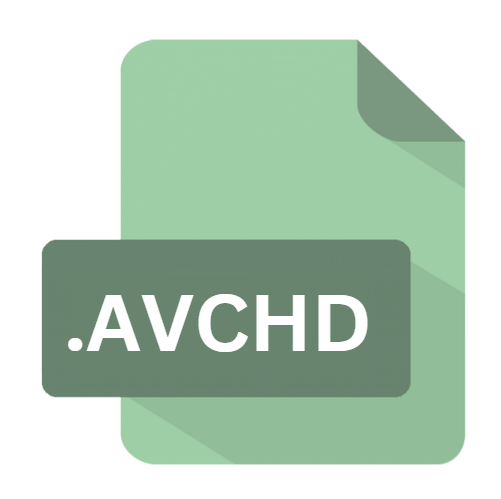.AVCHD File Extension

High Definition Video File
| Developer | Sony, Panasonic |
| Popularity | |
| Category | Video Files |
| Format | .AVCHD |
| Cross Platform | Update Soon |
What is an AVCHD file?
The AVCHD (Advanced Video Coding High Definition) file extension represents a format for recording and playing high-definition video.
Developed by Panasonic and Sony in 2006, AVCHD was designed to cater to the needs of camcorder enthusiasts and professionals who required a high-quality format that was both efficient in storage and robust in performance.
The .AVCHD format allows users to capture stunning, high-definition videos with sharp detail, vibrant colors, and immersive audio, making it a popular choice for those looking to preserve moments in exceptional quality.
More Information.
When AVCHD was first introduced, it marked a significant advancement in consumer video technology.
Prior to its development, most consumer camcorders relied on the DV (Digital Video) format, which, while capable, did not offer the high-definition quality that AVCHD promised.
The format was initially developed for recording 1080p video on digital camcorders, using highly efficient compression algorithms to ensure that large amounts of data could be stored on relatively small storage media like DVDs, hard drives, and memory cards.
AVCHD uses the H.264/MPEG-4 AVC (Advanced Video Coding) compression standard, which is known for its ability to compress video data effectively without sacrificing quality.
This made it possible for users to record longer videos in HD quality without requiring excessive storage space.
Alongside video, AVCHD also supports Dolby Digital 5.1-channel surround sound, providing a rich audio experience that complements the high-definition visuals.
Origin Of This File.
The AVCHD format was born out of a collaboration between Panasonic and Sony, two giants in the electronics and entertainment industry.
In 2006, as high-definition (HD) video technology was gaining popularity, there was a need for a video format that could support the growing demands for higher resolution, better audio, and efficient storage.
This need led to the development of AVCHD, which was introduced to the market as a format that could capture and store HD video on consumer camcorders.
File Structure Technical Specification.
The .AVCHD file format is not a single file type but rather a complex structure that includes multiple files and folders.
This structure is organized into a hierarchical format designed to manage the video, audio, and metadata in a way that ensures compatibility with various playback devices and editing software.
1. Video Codec: AVCHD uses the H.264/MPEG-4 AVC codec, which is highly efficient in compressing video data. This codec is widely supported across various devices and platforms, ensuring that AVCHD files can be easily played or edited.
2. Audio Codec: The format supports both Dolby Digital (AC-3) and Linear PCM (Pulse-Code Modulation) audio codecs. Dolby Digital typically provides 5.1-channel surround sound, while Linear PCM is used for uncompressed, high-fidelity audio.
3. File Structure: The AVCHD file system typically includes several types of files and folders:
- BDMV Folder: Contains metadata and information required for playback.
- STREAM Folder: Contains the actual video files with the .MTS or .M2TS extension.
- CLIPINF Folder: Holds information about each video clip, such as duration and format.
- PLAYLIST Folder: Contains playlists that organize the video clips.
- AUXDATA Folder: May include additional data or auxiliary files used by the camcorder.
4. Resolution and Frame Rates: AVCHD supports multiple resolutions, including 1080p, 1080i, and 720p. Frame rates can vary, typically including 24fps (frames per second), 30fps, and 60fps, depending on the recording settings.
5. Storage Media: AVCHD files are stored on a variety of media, including DVDs, hard drives, solid-state drives (SSDs), and memory cards, making it a versatile format for both recording and playback.
How to Convert the File?
Converting AVCHD files to other formats can be necessary for various reasons, such as reducing file size, enhancing compatibility with certain devices or software, or simplifying editing. Here are some common methods to convert AVCHD files:
1. Using Video Conversion Software:
- Software like HandBrake, Wondershare UniConverter, and Adobe Media Encoder allows users to convert AVCHD files into formats like MP4, MOV, or AVI. These tools often offer customizable settings for resolution, frame rate, and quality.
2. Online Conversion Tools:
- Websites like Online-Convert and Zamzar provide an easy way to convert AVCHD files without installing any software. However, these tools might have file size limitations.
3. Editing Software:
- Professional video editing software like Adobe Premiere Pro or Final Cut Pro can import AVCHD files and export them in different formats after editing.
Advantages And Disadvantages.
Advantages:
- High Quality: AVCHD delivers high-definition video and high-fidelity audio, making it ideal for professional and enthusiast video production.
- Efficient Compression: The H.264/MPEG-4 AVC codec ensures that video files are compressed efficiently, allowing for longer recording times without sacrificing quality.
- Compatibility: The format is widely supported across various devices, including Blu-ray players, computers, and editing software.
- Versatility: AVCHD files can be recorded on various storage media, providing flexibility in how they are stored and played back.
Disadvantages:
- File Size: Despite efficient compression, AVCHD files can still be quite large, particularly when recording in the highest quality settings.
- Complex File Structure: The hierarchical file system can be confusing for some users, especially when transferring or managing files across devices.
- Processing Power: Editing AVCHD files can require significant processing power, especially for high-resolution video, making it less accessible for users with lower-end hardware.
- Limited Compatibility: While widely supported, some older devices and software may not fully support AVCHD, leading to potential compatibility issues.
How to Open AVCHD?
Open In Windows
- VLC Media Player: An open-source media player that supports AVCHD playback without additional codecs.
- Windows Media Player: May require additional codecs or conversion to a more compatible format.
- Editing Software: Programs like Adobe Premiere Pro or Sony Vegas Pro can natively handle AVCHD files for editing and playback.
Open In Linux
- VLC Media Player: As on other platforms, VLC offers robust support for AVCHD playback.
- FFmpeg: A powerful command-line tool that can convert and play AVCHD files on Linux.
Open In MAC
- QuickTime Player: Generally requires conversion, as it doesn’t natively support AVCHD.
- iMovie/Final Cut Pro: Both of these Apple applications can import AVCHD files for editing and playback.
- VLC Media Player: Offers direct playback of AVCHD files without conversion.












